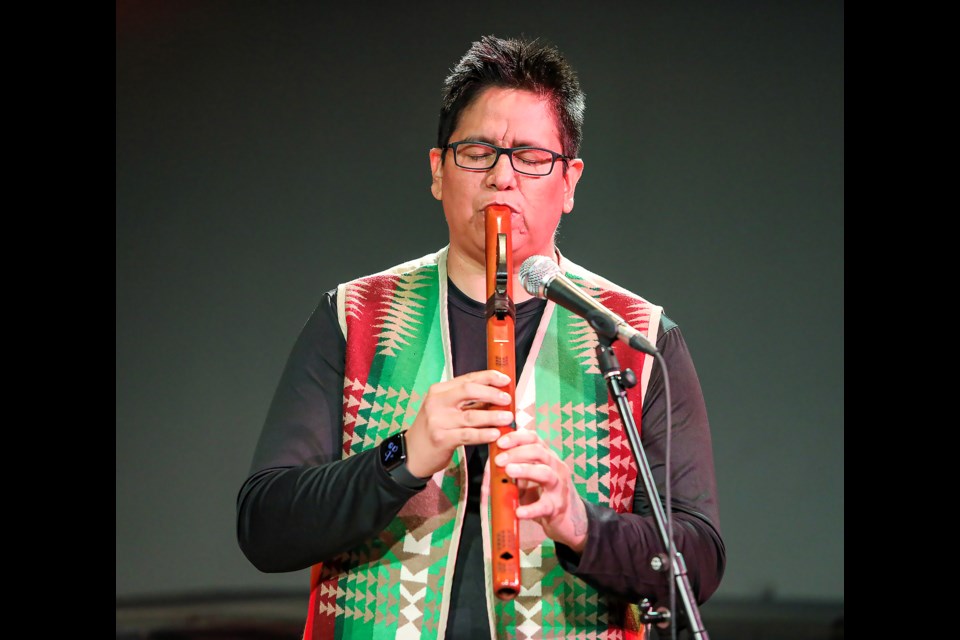CANMORE – Bits of tobacco bounced off an elk hide drum as three members of the Eya-Hey Nakoda drum group filled a theatre at Canmore artsPlace with the rhythmic sounds of Îyârhe (Stoney) Nakoda First Nation melodies and vocals.
Before patrons filed in for artsPlace’s latest Cultural Learning Circle highlighting Stoney Nakoda musicians, group members acknowledged the spirit of the drum – the life of the animal and the trees harvested to create it.
“In Stoney culture, the drum represents the heartbeat of our nation,” said Anders Hunter of Bearspaw First Nation.
Sitting in a circle with fellow drum group members Chris Pegram and Denzel Ear, Hunter began beating the drum to mimic the rapid, fluttering heartbeat of an unborn child still in the womb.
“It emulates our heartbeats as well,” he said, slowing the beat.
“Eventually, we come into the world and our heartbeat slows down to like a drum beat – a round dance beat.”
Thump-thump, thump-thump.
For the Îethkabi (Stoney Nakoda people), their belief is that they were born into the world knowing their language. They are an oral people and music is intrinsically part of that.
“With that, we came into this world also singing because when we were in the wombs of our mothers, we had lullabies that our mothers would sing to us when we were in her womb and when we came into the world,” said artsPlace Indigenous liaison Travis Rider, also of Îyârhe Nakoda First Nation.
The drum group, which mostly performs songs that they have composed, likens the sounds they produce to the natural noises made by other living beings and earthly phenomena.
Members of the group and their instruments – the drum and the wooden flute – all carry a spirit with a voice, said Hunter.
“A colleague of mine, Leroy Little Bear, he explained it really well,” he said. “We’re just conduits of the natural world where we are. I think we’re emulating the natural sounds of the world; the thunder; the way the eagle screams; the way the rivers flow; how you hear the wind.
“It’s all connected.”
Eya-Hey Nakoda members are predominately Îyârhe Nakoda from the Bearspaw, Chiniki and Goodstoney First Nations in Morley. They are, however, also proud to have had singers from other tribes such as Siksika, Cree, Muscogee, Shinnecock and Aniyvwiya.
Hunter’s brother-in-law, Pegram, is from Shinnecock First Nation based at the eastern end of Long Island, N.Y. Pegram married into the Îyârhe Nakoda, but recalls hearing the sounds of the tribe long before he met his wife, Shanda Hunter.
He credits much of the First Nations sound to pioneers like his father-in-law, elder Rod Hunter and the Chiniki Lake Drummers.
“I was 10-11 years old out east and we used to listen to Chiniki Lake on 8-track tapes going to powwows,” said Pegram. “My father-in-law essentially gave birth to the contemporary style of singing, but he’s a humble man and would never say that."
When he came up with the drum group, he brought with him upbeat melodies and songs of celebration that took the powwow scene by storm.
A friendship song that he composed is just one example of the songs still commonly performed at powwows and other cultural events today.
His son performed the song solo, paired with a hand drum to kick-off the Cultural Learning Circle.
The event, held Oct. 25, was the first in-person session artsPlace has held since the inception of the learning circle series in 2020.
Program coordinator Nicole Fougére said it seemed fitting that the theme of the first in-person session was music. The whole idea of the series is to create a culture of inclusivity by celebrating diversity, but also through shared learning, connections and experiences, and there is a universality to music that can bring an audience or a room together unlike anything else.
“For me, music is intrinsically a part of being alive,” said Fougére. “Hearing the Stoney musicians singing and playing the drum at the cultural circle, I felt it deep in my bones.
“I believe that is an experience shared by many of the audience members, we can all relate music to important moments in our lives – births, deaths, weddings and ceremonies of all kinds. There is a healing power to music that all people and cultures can relate to.”
The Local Journalism Initiative is funded by the Government of Canada. The position covers Îyârhe (Stoney) Nakoda First Nation and Kananaskis Country.




